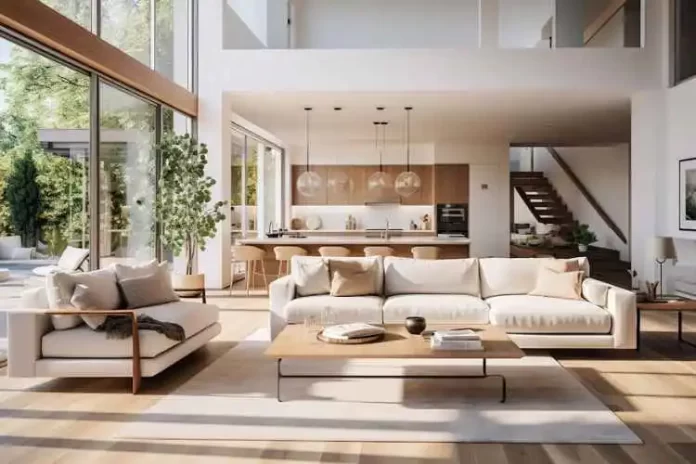Home design stands out for its personal and intricate nature in the vast world of design. Creating a living space isn’t just about looks; it’s about building an environment that aligns with your lifestyle, stirs emotions, and feels like home.
Dive into home design and discover a harmonious blend of visual charm and functionality. So, how do you transform a house into a space that mirrors your essence and caters to daily needs? Read on to find out.
- The Art Of Color: Why Color Selection Matters
Stepping into a room, color often demands your immediate attention. Colour selection for house isn’t just about matching your sofa or drapes. The right palette can evoke feelings and set a mood. Some colors even sway your mental and physical state.
Beyond walls, colors dictate the choices of furniture, textiles, and artwork. An earthy palette might lean towards rustic wood, while bright tones might favor contemporary designs. Harmony in color choices is key; cohesive shades bring balance while clashing colors can disrupt.
It’s also essential to remember that lighting significantly affects color perception. A color that’s captivating by day can shift under evening lights. Play with different shades to ensure consistent appeal throughout the day.
- Furniture: Beyond Seating And Storage
Furniture isn’t just functional; it sets the aesthetic tone. Different forms, materials, and styles can change a room’s vibe drastically. While minimalist pieces offer a modern feel, antique items provide a touch of nostalgia.
Placement matters, too. An open layout feels welcoming, whereas strategic arrangements can craft intimate spaces. Think of furniture as characters in a story, with their positions and relationships defining the plot.
Never underestimate the power of auxiliary pieces like side tables or unique shelves. While they serve specific functions, they can also heighten or diversify the room’s theme.
- Lighting: Crafting Spaces And Moods
Lighting is transformative. Its brightness, source, and hue can instantly redefine a space. While overhead lights provide overall illumination, task lights cater to specific areas, and accent lights highlight design features.
The design of the fixture itself is influential. It can firmly ground a room’s style, whether a sleek pendant or a grand chandelier. So, when choosing lights, weigh both their practical and aesthetic impacts.
Natural light is another game-changer. How sunlight filters in, casts shadows, and warms the room can redefine its aura. Position windows, skylights, and doors strategically.
- Textiles And Textures: Quiet Transformers
Soft furnishings play a pivotal role in home design. Elements like pillows, rugs, and curtains infuse color, pattern, and tactile sensation, enriching the sensory experience. But these elements are not merely decorative.
Textiles insulate, safeguard your items, and can even muffle sound. A thick rug, for example, can hush footfalls, ensuring a serene setting. But moderation is essential.
Too many patterns can overwhelm you, while sticking to one texture might bore. Strive for a balanced blend that elevates the room’s elegance.
- Flooring: Laying The Design Foundation
Your floor doesn’t just support—it sets a design mood. Whether the warmth of wood or the luxury of marble, it influences the room’s feel. Durability matters, especially in high-traffic zones.
While a bedroom might bask in carpeted comfort, bustling areas benefit from sturdy materials like hardwood. Pairing the right floor with the room’s purpose ensures it remains beautiful and practical.
The floor can dazzle or stay subdued, standing out or letting decor take center stage. Recognize its role in your design story for the best effect.
- Space Utilization: Maximize Every Corner
Space isn’t just about size; it’s about function. Make every inch count, whether designing a mansion or a modest flat. Multipurpose furniture can be a game-changer for smaller spaces. In larger areas, zoning for different activities makes sense.
Clear pathways, logical arrangements, and seamless transitions between rooms promote harmony. Aim for an equilibrium, avoiding both clutter and stark emptiness.
- Art And Personal Touches: Adding Soul
While design principles set the stage, your personal touches breathe life into the space. It should echo your experiences, tastes, and cherished memories. They add depth, whether it’s artwork, cherished photos, or a curated bookshelf.
Sometimes, subtlety speaks volumes. An heirloom, a DIY project, or even your unique arrangement can say a lot. These often-overlooked details tell your story.
- Flow And Continuity: Connecting The Dots
A home tells a story, with flow and continuity weaving it together. Ensuring consistency across rooms guarantees a cohesive feel. A sense of unity emerges through shared color themes, consistent designs, or repeated motifs.
But consistency isn’t monotony. Rooms can retain individuality while echoing broader themes. Highlighting these nuances enhances your home’s innate allure.
In Summary
Home design balances art and practicality. It requires juggling aesthetics with functionality. It’s not merely about chasing trends but ensuring spaces reflect you while serving their purpose. By integrating these principles, embark on a fulfilling home design journey, crafting spaces that exude warmth and personality.


